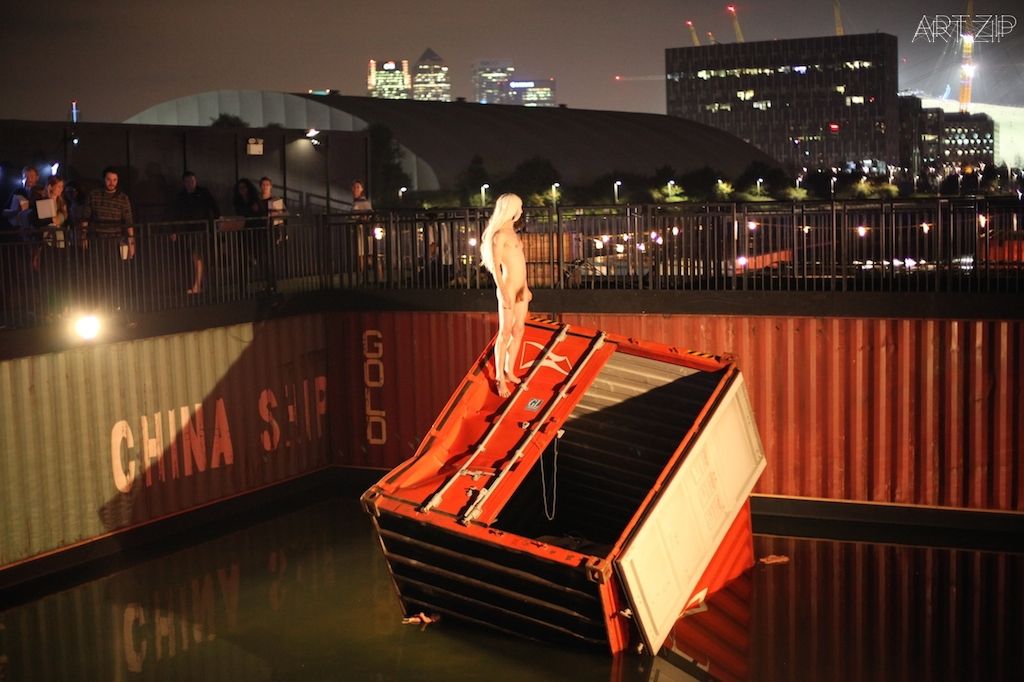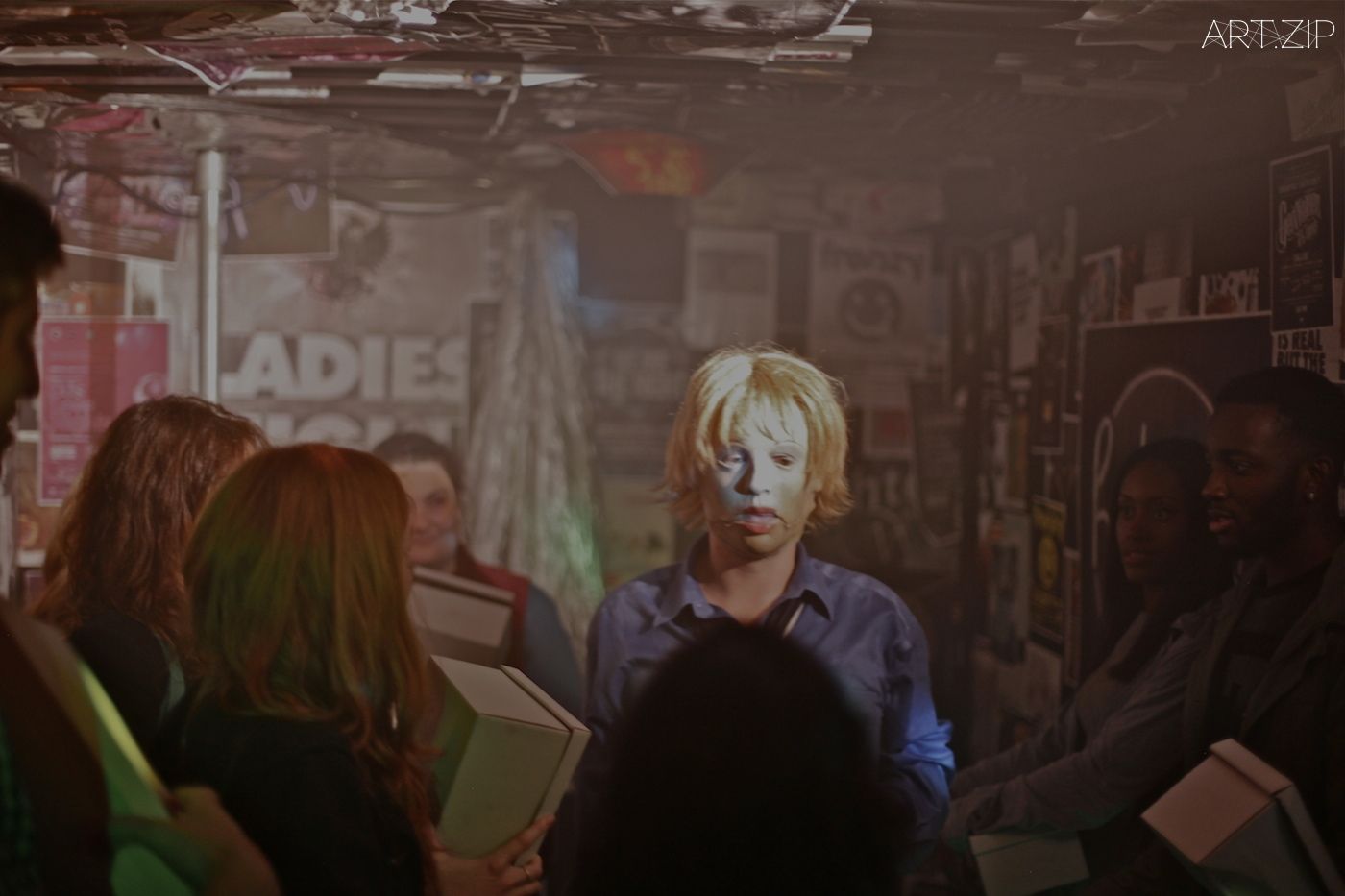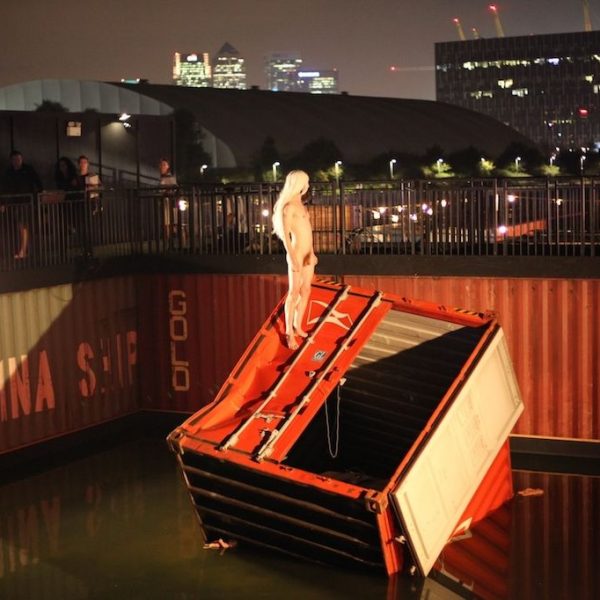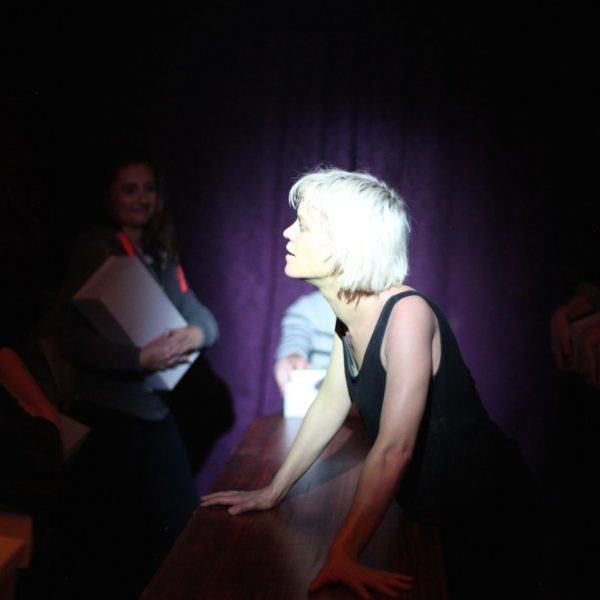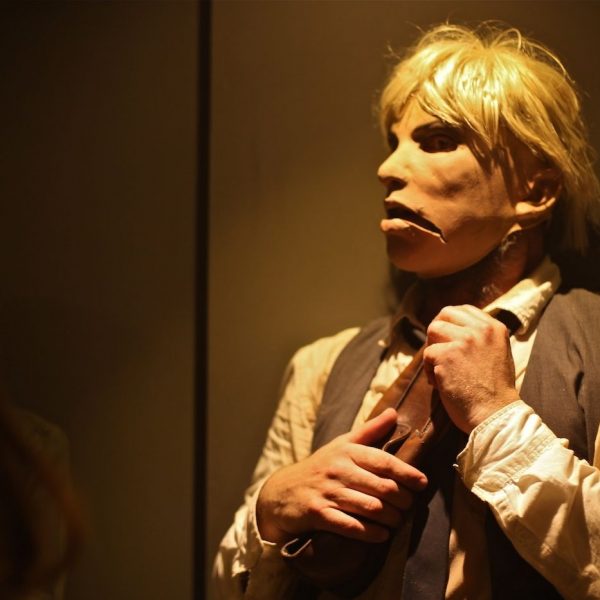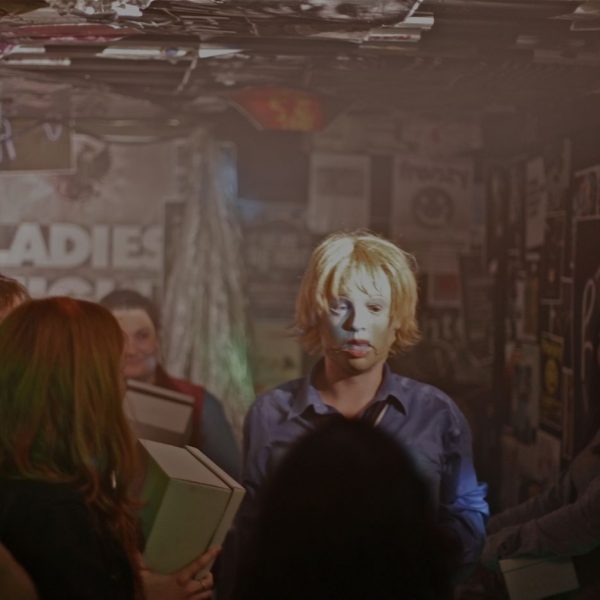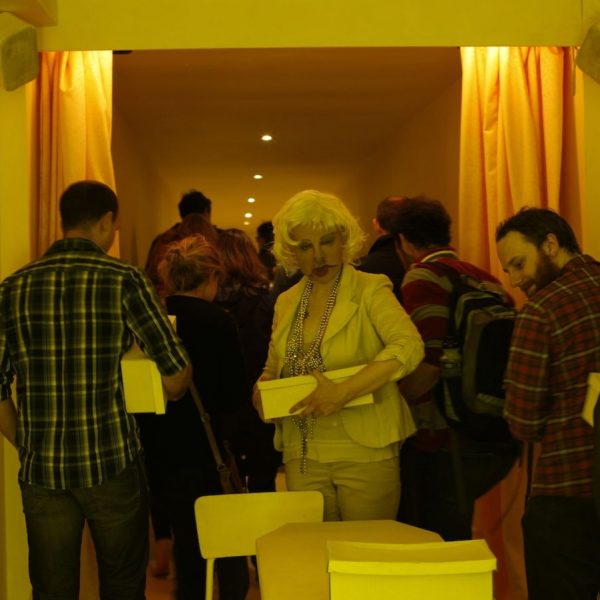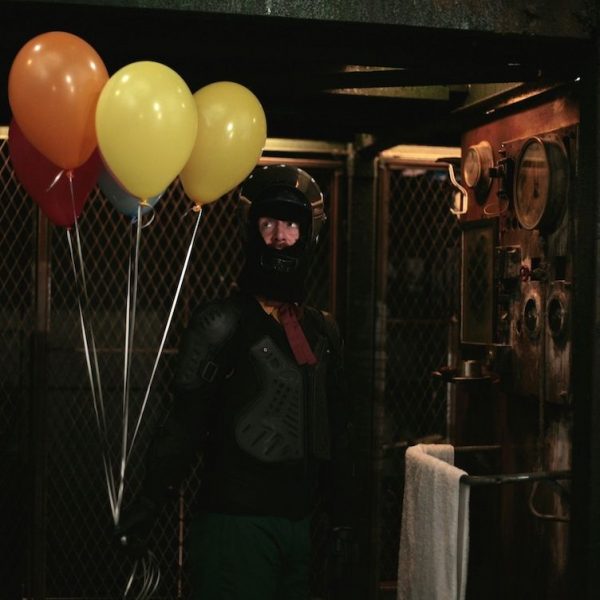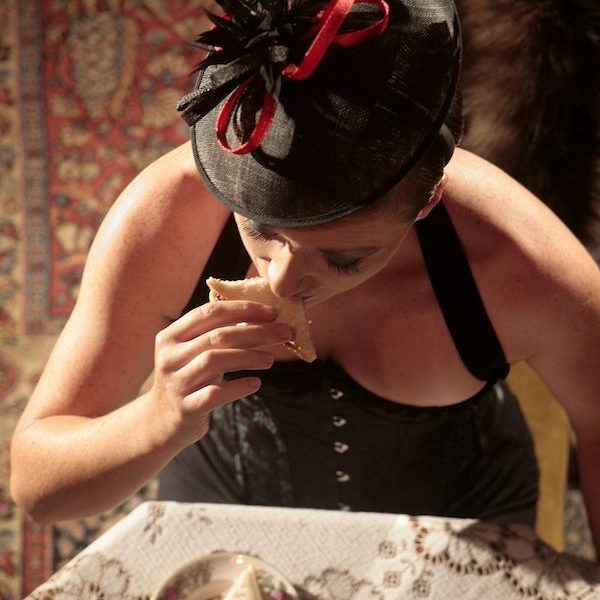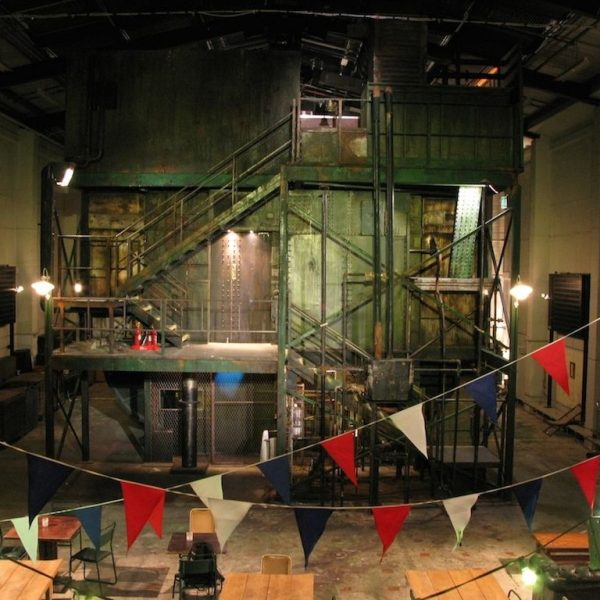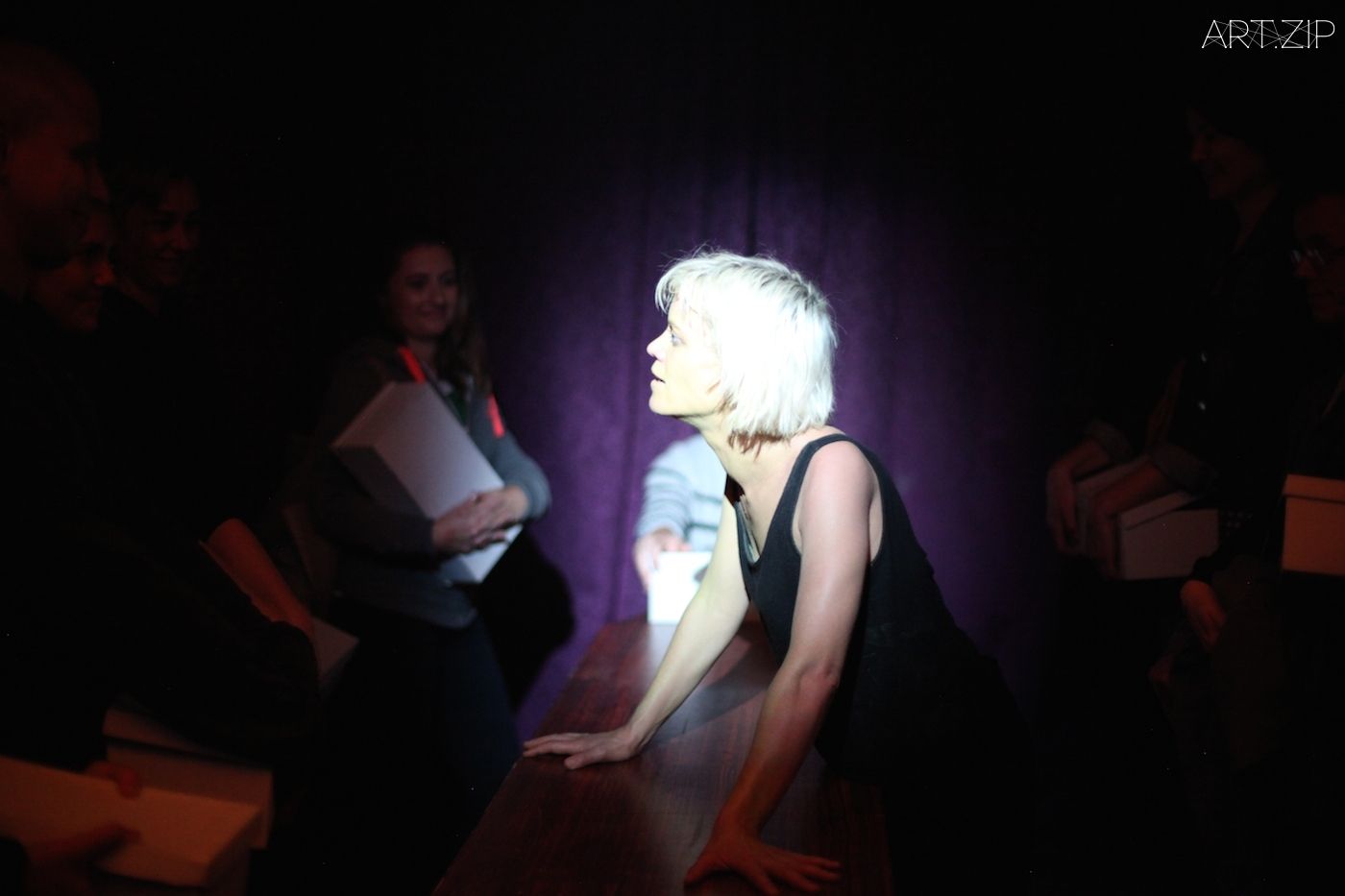
Text by: Struan Robinson / 撰文:Struan Robinson
Translated by: Shen Xinyi / 翻譯:沉心懿
“shunt” was founded by ten artists from Central School of Speech and Drama, who met in 1997 whilst doing a one year postgraduate course. Its beginnings as a collaborative effort has become the group’s defining feature, as embodied in the company’s title as a ‘collective’. It operates as a company which devises its own material – various, slightly interlocking themes are agreed upon by the group as a whole before each member brings forward a different proposal for each scene in an effort to challenge the traditional theatre model of a single author. As a result of the huge amount of collaboration the company does, often what appear to be disparate and unrelated ideas come together through the collective creativity of the group. Their work tends to be site-specific and evolves during the devising process alongside their often-changing environment. Much of the time, the collective’s message is unclear at the beginning of a run, developing only as the weeks go by and reaching a fully-formed idea by the end of the run. Perhaps one of the first companies to define themselves as being ‘immersive’, shunt have paved the way for companies such as Punchdrunk and You Me Bum Bum Train to infiltrate their way into the public consciousness. But shunt remains, unlike these arguably more commercialized entities, on the fringe of the mainstream, delivering productions and performances that are perhaps a little too disturbing and avant-garde to really become commercial fodder.
尚特劇團(shunt的本意為”分流”)的十位戲劇實踐者相遇於1997年英國皇家中央演講與戲劇學院的碩士課程。正如劇團的名字所指,他們的協作模式成為了劇團獨樹一格的標誌,並已延續至今。團隊的運作方式是經由集體決定一系列相互關聯的主題,並在創作過程中采用成員對素材的獨到見解。因此他們的每一部作品都是由不同風格的段落所組成,以此挑戰由一人創作導演的傳統戲劇模式。通過公司的大量集體創作,許多風格迥異,怪誕的想法能夠在舞臺上得以呈現。他們的作品經常發生在特定場地,而劇本本身也在創作過程中得到不斷得改進。在很多情況下,劇團希望傳達的主題在創作初始並不明確,往往需要一段時間的發展才能塑造成型。
尚特劇團也許是最早自我定義為”體驗式”(immersive,行業內也會翻譯成沈浸式)風格的戲劇公司,這種理念甚至影響了如今廣為人知的眩暈劇團(Punchdrunk)以及你我笨笨車(You Me Bum Bum Train)等戲劇公司的運行模式,為它們如今的普及鋪平了道路。然而,相比後者的商業化,尚特劇團保持了它一慣的先鋒精神,在主流戲劇的邊緣區域推行更叩響人心、更具實驗性質的作品。
As a theatre company, shunt have always proved divisive in nature, often alienating mainstream theatre critics and appealing mainly to their risk-taking and loyal fans, to whom their work is most definitely aimed at. A lack of focus and coherence, an attack on style over substance and a lack of understanding the message behind shunt’s work makes up most of the criticism against them. shunt combine multiple forms of media, such as video installation, dance, acrobatics and acting, it has even been suggested by several that shunt work better as a performance art installation company rather than a theatrical one. But at the heart of shunt’s work is the relationship between audience and performer which is pushed and pulled and examined intently by the collective, a relationship which can clearly only be truly found in the theatrical medium. Their audience tends to be one which relishes the uncertainty of a shunt performance; who delights in the non-sequiturs and unabashed weirdness of the production and draws out broad themes from them which can be pulled apart and discussed after the show. It is quite clearly not a theatre company for those who favour proscenium arches and dislike audience participation.
作為一個老牌劇團,尚特在骨子裡有些叛逆。他們總是與主流的戲劇評論爭鋒相對甚至疏遠,這反而受到那些具有冒險精神的死忠粉絲的喜愛,而他們也是尚特劇團作品主要針對的人群。認為作品內容缺乏重心和連貫性,作品風格過於強烈以至於壓過了實質內容,以及缺乏對作品思想的解讀充斥於主流劇評對他們的品論。尚特劇團的作品常常是多種表現形式的組合,例如對錄像視頻裝置的運用、舞蹈、雜技以及表演,甚至許多人覺得尚特劇團會更適合做一個表演裝置藝術公司而非劇團。然而,由於他們作品的核心旨在不斷探索觀眾和演出者的關系,很明顯,演出者只能以戲劇的形式將兩者關系拉進、推遠,如此心無旁騖的摸索才能得到檢驗。他們的觀眾也習慣於把作品中的不確定的、不合邏輯甚至荒誕的因素拿來津津樂道。因此很顯然,尚特劇團是針對於偏愛觀眾參與而非傳統舞臺表演的觀眾存在的。
shunt’s piece ‘The Architects’ was promoted by the National Theatre in 2012 but took place in a disused biscuit factory in Bermondsey, signaling their status as a respected but still alternative company. Once again exploring and pushing against ideas of space and illusion and taking cue from the Greek myth of Theseus and the Minotaur, the company deliberately created a totally confusing sensation for the audience, creating a wooden labyrinth which gave way to a luxurious ocean liner, all within the confines of a South London warehouse.
尚特劇團作品《建築師(The Architects)》於2012年得到了英國國家劇院的制作推廣,特別選擇的演出地點竟是位於東南倫敦伯蒙西地區的一座廢棄的餅幹廠,這昭示著他們在戲劇圈內另類但受人尊崇的地位。該作品以希臘神話《米諾陶的忒修斯》為線索探索空間和幻覺的的奧義,他們在這座位於倫敦南部空間有限的倉庫內搭建了一個木質迷宮–這座迷宮最終通往一艘奢華的遠洋客輪,為觀眾創造了一個極度迷幻的觀看體驗。
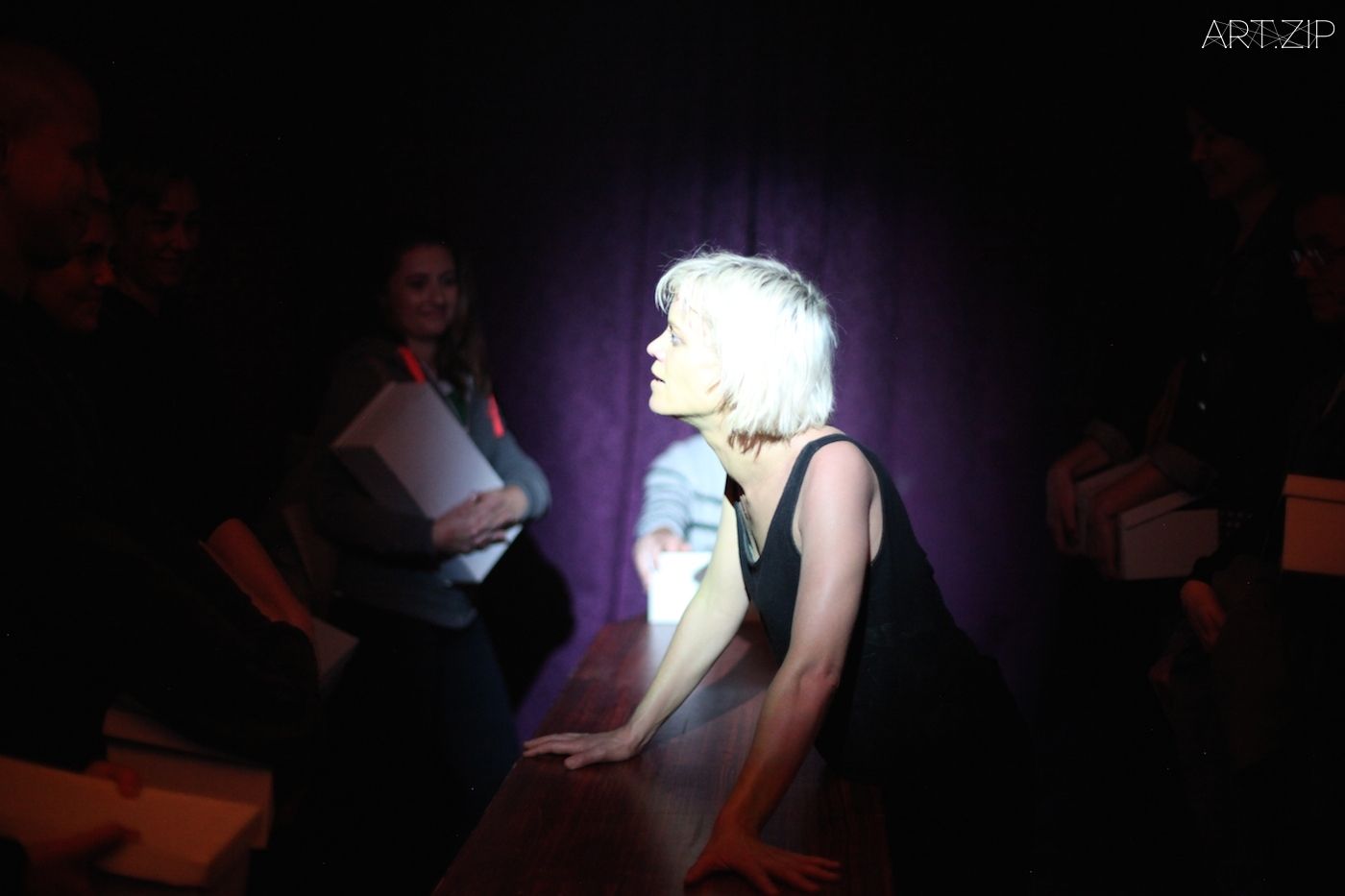
The Boy Who Climbed Out Of His Face by shunt, 2014, Performer Gemma Brookis, Photo by Susanne Dietz
The company’s latest production is a 45-minute promenade piece set in multiple shipping containers in a Greenwich Port called ‘The Boy Who Climbed Out of His Face’. Finishing in late September 2014, a great deal of secrecy shrouded the production. As usual with shunt, the space in which the performers worked became integral to the piece itself. Taking its cue from Charles Kingsley’s Victorian moral fable ‘The Water Babies’ and Joseph Conrad’s seminal post-colonial work ‘Heart of Darkness’, an aura of dread and fear crept into the production somewhat accurately, as true moments of terror tended to pervade the awkward silences. Unlike the immersive productions of Punchdrunk however, this production did not allow the audience to wander and explore on their own, but rather invited them on a journey alongside the performers in what transpired to be a fairly twisted game of ‘follow the leader’. An idea of sensation ran throughout the piece, from the moment the audience were asked to remove their shoes and socks before they enter, creating an uncomfortable proximity with the performance itself that was emphasised by the claustrophobic contains of the set itself which often plunged the audience into pitch blackness. This is all part of shunt’s ethos – a determined desire to put the audience into a visceral situation so disorientating that they cannot just remind themselves that they are watching a piece of theatre, but have to admit to themselves that they are living it instead. Alternately nightmarish and enlightening, ‘The Boy Who Climbed Out of His Face’ remained a divisive piece for critics and audiences alike.
他們最近的作品被命名為《從自己臉中爬出來的男孩(The Boy Who Climbed Out of His Face)》,這部時長45分鐘的體驗式戲劇作品將演出場地設在格林威治港海運集裝箱之間。和往常一樣,作品本身和空間融為一體。利用查爾斯·金斯利(Charles Kingsley)的兒童文學作品《水孩子(The Water Babies)》和約瑟夫·康拉德(Joseph Conrad)寫於後殖民時期的小說《黑暗之心(Heart of Darkness)》作為該作品的兩條故事線索,使得它蔓延著一種恐怖的氣氛,在海港集裝箱之間那種寂靜的環境中尤甚。與暈眩劇團的體驗式戲劇作品相反,該作品並不允許觀眾在場地內自由穿行探索,而是邀請他們緊隨表演者的步伐進行一次令人膽戰心驚的”跟我走”遊戲。感官體驗貫穿整部作品,從觀眾在開場前被要求脫掉鞋襪開始,通過讓觀眾置身在令人感到幽閉恐懼的漆黑集裝箱內,營造並強調了一種近距離體驗演出的壓抑感。尚特劇團的作品風格是如此強烈,他們從始至終都熱衷於用真實的場景把觀眾從現實中剝離,從而使他們忘記自己是在觀看表演,而承認自己是故事發展的一部分。撇開作品的恐怖氣氛和啟發意義,《從自己臉中爬出的男孩》一如既往地在劇評家和觀眾中極具爭議性。
- The Boy Who Climbed Out Of His Face by shunt, 2014, Performer Tom Lyall, Photo by Susanne Dietz
- The Boy Who Climbed Out Of His Face by shunt, 2014, Performer Gemma Brookis, Photo by Susanne Dietz
- The Architects by shunt photo by Susanne Dietz performers Gemma Brockis
- The Architects by shunt, 2011/2012 photo by Susanne Dietz performers Gemma Brockis
- The Architects by shunt photo by Susanne Dietz performers Nigel Barrett, Gemma Brockis & Hannah Ringham
- Money by shunt, 2010 photo by Susanne Dietz performers Heather Uprichard
- Money by shunt, 2010 photo by Susanne Dietz performers Simon Kane
- Money by shunt, 2010 photo by Susanne Dietz The Machine, set design Lizzie Clachan
Interview with shunt co-founder David Rosenberg
專訪尚特劇團聯合創始人大衛·羅森伯格
ART.ZIP: Where do ideas come from? Contemporary, zeitgeist issues or ones that are more transcendent, like ideas about love and death? Which out of the space or the theme for a production comes first?
DR: Initial starting points for performances might come from a particular space; a physical perspective that we want the audience to have on an image, an idea for a role that we want the audience to play or occasionally from an existing text or historical account. With all our shows the dialogue is usually the last element to get added and the most vulnerable to change over the run.
ART.ZIP: 你們從哪裡面獲取靈感?是從當代潮流事件還是更抽象一些的主題,比如說關於愛和死亡的思考?作品最初是先有空間還是主題?
DR: 表演也許會從某一個特定的空間獲得啟發;一幅圖像,某種觀眾角色的想法甚至是已有的文字或歷史事件等等都能夠為我們想要的最終呈現提供一種具象的角度。而我們所有的作品中,對話都是最後一個被加入的元素,也是整個演出過程中最易變的。
ART.ZIP: So much of shunt’s ethos focuses on displacing the audience and exploring the relationship between performer and audience. What can that tell us about the value of theatre?
DR: As increasingly more of our culture is consumed alone in front of a screen – live performance is an indispensable opportunity to bring people together in the same space. Given that the audience has made this effort to leave the couch it seems unfair to ignore them. When we are disorientated, uncomfortable, nervous then we might see or feel things in a different way (or we might get disappointed, frustrated and angry – oh well, there’s just no pleasing some people)
ART.ZIP: 尚特劇團的大多數作品都著眼於觀眾的空間位移,以及探索表演者和觀眾的關系,這能體現什麼戲劇價值呢?
DR: 現今越來越多的觀眾會選擇坐在屏幕前–但事實上,現場演出是一種使觀眾能相聚於同一空間的不可或缺的方式。當然觀眾這麼合作地從沙發上爬起來了,我們更要努力工作來回應他們。當我們感到不知所措,緊張不安時,我們會用不同的角度看東西 (不然我們會覺得失望、焦慮或憤怒 — 沒辦法,有些人總是那麼難以取悅。)
ART.ZIP: How does immersive theatre fit into the category of visual theatre?
DR: The first time I was immersed was playing Donkey Kong in the 80’s. My avatar was only a handful of pixels but I was him, I became him, and in order to become him my imagination was required to fill a gap. This gap is becoming increasingly narrow.
I go to the cinema to escape from a dimension – pretty much everything else i do is in 3D so what I expect from the cinema is one dimension less. The additional dimension currently offered, although it advertises itself as a greater immersive experience is, for me, paradoxically less immersive. Imagine a man with electrodes placed in three distinct areas of his brain – when he presses the green button he experiences a sensation of sexual pleasure, the yellow one – a nostalgic pleasure, and the red one a crazy visual hallucination that is also in some way pleasurable.
I think this man was used as an argument against hedonism, however it could equally be used as an argument in support of hedonism, for the fence has become almost as wide as the two gardens that it divides and consequently it is very difficult to find anywhere else to sit.
The term immersive is now a marketing idea rather than an authentic one, in fact authentic is now also a marketing idea: a technique for corporations to attempt to not sound corporate. It would seem to me that if a corporation wants to be authentic then they should probably attempt to sound as corporate as possible.
When I’m a doctor – I want to sound like a doctor I don’t want to sound like another patient – that’s confusing.
But these doubts have not stopped us from making what have been described as immersive experiences usually by other people but sometimes ourselves – for marketing reasons. Pop-up is also a misleading term.
ART.ZIP: 體驗式演出如何被規類到視覺戲劇呢?
DR: 我的第一次體驗式表演是在80年代扮演大金剛(Donkey Kong)。這無非是一些像素組成的卡通形象,但是我確確實實是它。為了使表演惟妙惟肖我需要彌補我想象力的缺口。這個缺口正越變越窄。
我通過電影院來感受平面空間–基本上我們的生活工作都是在三維環境中度過,而電影院提供的是一種二維空間。盡管他們現在廣告說的多維度電影能帶來更強烈的視覺體驗沖擊,這也許會有些矛盾,但是對我來說並非如此。想像一個人在他腦袋中的三個區域放置有電極:他按下綠色鍵的時候能感受到性快感,黃色鍵是一種懷舊的愉悅感,而紅色鍵帶來的瘋狂的感官幻覺刺激,從某種意義上來說也充滿了快感。
我認為這可以用來當做駁斥快樂主義的論點,當然它也同樣能支持快樂主義論。畢竟這兩者的區別非常模糊。
現如今”體驗式”戲劇更多得被用來做市場推廣而不再保有它的本來面貌了。事實上”真實性”也在廣告上大行其道:這是一種讓一個公司聽起來不像是盈利機構的技巧。但是對我來說”真實性”就意味著這個公司應該完全按照公司那套行事。
如果我是醫生,我希望我聽起來就像是個醫生,而不是病人–這挺令人困惑的。
盡管有這些疑問,我們仍舊在制作在大眾理解下的體驗式風格的作品,有時候我們為了市場推廣自己也會這麼說。
ART.ZIP: How does shunt differ from companies like Punchdrunk which have sprung up in its wake?
DR: There are increasingly more companies in London who are making work outside of the auditorium. We will always be compared with each other due to our common interest in abandoned buildings and mobile audiences but I’m not sure how useful it is to compare other elements of our work. The thing that most typifies shunt’s contribution to this whole thing is our pathological inability to capitalise on what has been successful in a previous project and roll it out in the next. We are constantly making our second album.
ART.ZIP: 和新近湧現的暈眩劇團等戲劇公司相比,尚特劇團有何不同?
DR: 在倫敦有越來越多的戲劇公司把場地搬到了劇場之外,對廢棄的建築以及移動觀眾的共同偏愛使我們總是被相互比較。但我很懷疑因此將作品本身進行對比是否有效。我們對於這種戲劇類型最有代表性的貢獻大概就是我們對於往期作品的成功元素毫無認知能力,以至於完全無法在新的作品中加以利用。我們永遠需要不斷得探索創新。
ART.ZIP: shunt’s productions are hugely influenced by their current location/every different audience. Is it difficult to archive and store past productions if every experience is so different?
DR: Neanderthal man, as far as we know, didn’t produce any art, which makes them, in our eyes… a bunch of Neanderthals. But maybe they were more into performance art or immersive events, which are, as we know, notoriously difficult to document.
Their only true legacy is a gently disappearing memory. How did such an ephemeral art form get stuck in such old and inflexible buildings? The shunt archive is a vast and as yet unorganized mass of stuff that Susanne Dietz (shunt associate artist, documenter and video designer) will hopefully pummel into shape next year.
ART.ZIP: 尚特劇團的作品都極大地受到了作品發生地點以及每一位獨特觀眾的影響,這使得每一部作品都風格獨特,這樣一來是否很難將它們存檔和記錄?
DR: 據資料顯示,尼安德特穴居人從來不做任何形式的藝術創作,以至於在我們眼中他們只是一群普通的尼安德特人而已。但也許他們更樂意做表演,或是體驗式的活動,而這些都是很難被記錄證明的。
他們唯一留存於世的是逐漸消失的記憶。如此短暫如曇花一現的藝術形式怎麼能被那些老舊笨重的建築禁錮呢?尚特劇團的檔案數量十分龐大而雜亂無章,我們期待我們的合作藝術家以及歸檔人員和視頻設計者蘇珊·笛茨(Susanne Dietz)能在明年將它們好好整頓一番。
ART.ZIP: Why has shunt proved so divisive with critics? Do you think the critics are missing out on the point?
DR: Who knows – we have also been divisive with audiences – no one has to like everything. Sometimes critics are factually wrong about what they write – this is more annoying. That’s like us not bothering to turn the amps on.
ART.ZIP: 為什麼尚特劇團總是與主流劇評家意見不合?你覺得他們有說到點子上嗎?
DR: 誰知道呢–我們和觀眾也經常觀點不合–沒有人需要喜歡所有事的。有時候劇評家寫的東西真的是錯誤的–這就像我們嫌麻煩不開燈那樣更惱人呢。
ART.ZIP: Would it be in the company’s interests to go overseas and bring their productions to other audience e.g. Chinese audiences? What would be the company’s pick for a production that could introduce shunt to a Chinese audience that embodies their ethos best?
DR: It would be very difficult to take a shunt production from the past and try to restage it. There would be much greater interest to create something new made specifically for the space and audience. It would also be of interest to work in collaboration with local artists in the creation of a new performance. Our ethos (other than to ‘explore the live event’) has been profoundly malleable over the years and has probably been defined by each performance rather than the other way round.
ART.ZIP: 公司會不會有興趣將作品移到海外,並面向外國觀眾,比如說,中國觀眾,什麼樣的作品最能夠將尚特劇團的精神呈現給中國觀眾?
DR: 把以往的尚特劇團作品直接搬到海外會非常難。我們會更有興趣根據當地的場地和觀眾特點重新創造一臺新的體驗式戲劇作品。我們也很有興趣和當地的藝術家合作。我們的作品精神(除了”對現場活動的探索”)在過去幾年中被不斷打破,與其說有一個統一的定義,倒不如說每一場演出都在為它增添新的定義。
ART.ZIP: Surely the point of theatre is that there is a distinct separation between audience and performer – what is gained by immersing the audience directly into the action?
DR: I would suggest that given this binary choice then – the point of theatre is to remove the separation between the audience and performer – this can happen in an auditorium as powerfully as in a railway arch (our home for over 10 years). There are things that become more complicated when the audience are in the middle of the whole thing: they seem to need a reason to be there, they are of course always the audience but now they have a parallel role and that needs to be worked into the narrative. If they are not to be ignored then the performers need to have a way of communicating with them which also makes sense of the performers’ predicament.
ART.ZIP: 戲劇的意義在於它區分開了觀眾和表演者,那麼引導觀眾體驗參與劇情發展有什麼突破呢?
DR: 我得說在這個二項選擇題中,戲劇的意義在於它將觀眾和表演者之間的鴻溝抹除了–這在傳統劇場或是一個鐵路拱橋中都是一樣的(這是我們10年來的家)。而觀眾沈浸於故事發展會將整件事復雜化:他們好似需要一個呆在那兒的理由,當然他們的角色永遠是觀眾,但與此同時他們又被賦予了一個新的角色,一個平行於”觀眾”的存在並符合故事發展邏輯。如果這樣的角色成為演出不可忽略的一部分,那麼表演者必須使用某種方法和他們產生交流,這也解釋了他們在演出過程中遇到的一些困境。
ART.ZIP: How do you find performance sites? Is there something specific that you look for? Did you know (for example) that for The Architects you wanted a disused biscuit factory or for The Boy Who Climbed Out of His Face that you wanted the jetty?
DR: The question we asked ourselves for those two productions were – ‘We have a biscuit factory – what shall we do in it?’ And ‘We have a slab of concrete in the middle of the Thames – what can we use for a windbreak?’ Because you never know what building or site is going to make it through the increasingly arduous task of acquiring it, it has made more sense to us to sort out the site and then think how it could filled with performance.
ART.ZIP: 你們是如何定位或尋找演出場地的?在尋找過程中有特定的條件嗎?舉個例子,在創作《建築師》初期你們是否知道想要使用一個廢棄的餅幹廠,或者《從自己臉中爬出來的男孩》需要哪個碼頭?
DR: 我們在創作這兩部作品時面臨的問題是:”好了,這有一個廢棄餅幹廠,我們能做些什麼?”以及”在泰晤士河中央有一些混凝土板,我們能用來做擋風板嗎?”你永遠預料不到到底哪一個場地或建築能最終被我們突破重重關卡而獲得使用權,所以更好的方式是我們先解決了供使用的場地,然後在此基礎上去想表演該如何進行。
ART.ZIP: What do you want audiences to come out of a shunt show thinking?
DR: Have we left yet? How did I get so drunk? When will this ringing in my ears stop? I never want it to stop; as long as my ears are ringing then I am free from responsibility and pain.
ART.ZIP: 你希望觀眾在觀看完尚特劇團的作品後想些什麼?
DR: 我們真的離開了嗎?我怎麼喝得這麼醉?什麼時候我耳朵裡的聲音才會停下?我希望它永遠別停下來,只要它不停我就不再有責任和痛苦了。
ART.ZIP: Is immersive theatre bringing in a new breed of theatre goers?
DR: There are now many companies who have made a great effort to reach out to new audiences either through presenting work in exciting and surprising locations or making the whole thing more of a fun night out or a social event. It’s difficult to know whether these audience’s are ‘theatre goers’ or simply the audience for all this new work. But whoever they are – there are loads of them.
How important is the visual aspect to a shunt performance? Obviously it’s all about sensation so you incorporate touch and sound as well as sight.
ART.ZIP: 這種體驗式的戲劇模式是否帶來了一批不一樣的新戲劇愛好者?
DR: 現在有許多的公司都在努力以各種形式與新興觀眾溝通,例如在很有意思的場合呈現創作,或者以主題晚會或社交活動的形式出現。很難說這些人真的是戲劇愛好者還是僅僅是被新作品吸引的人。不管他們是誰,人數真的很多。
尚特劇團的視覺效果在表演中有多重要?很明顯這是感官體驗的一部分,所以融入觸覺、聽覺和視覺很重要。
ART.ZIP: shunt productions appear to be sensation driven – are we not missing out on broader themes? This is a problem a lot of mainstream media outlets have with the company.
DR: I’m not sure whether all shunt performances are sensation driven although that doesn’t mean we are not also missing out on broader themes. We are always trying to create enough space for the audience to also occupy the performance. We enjoy a certain amount of confusion and unknowing and we are always try to place ourselves and the audience on a knife edge between narrative and abstraction. The problem with this route is that it’s very easy to fall of either side and every audience member has a different idea of where the knife should be placed.
This means that we can guarantee that our work will not be for everyone. Luckily there is loads of other theatre.
ART.ZIP: 尚特劇團的作品大多都以感官刺激為驅動力,觀眾是不是會因此忽略了一些更大的主題呢?這也是主流媒體對你們公司批判的問題。
DR: 我不確定我們所有的作品都是以感官體驗為主,但是這並不意味著我們忽略了更重要的主題。我們一直在嘗試創造足夠的空間來讓觀眾參與到我們的表演中來。我們很喜歡加入一些疑惑和謎題,我們同時也樂於把自己和觀眾推到抽象概念和實際敘述的刀口上。隨之而來的問題是觀眾對劇目的理解可能會出現向不同方向發展的情況,而每一個觀眾對於這把刀該放在哪個位置都持有不同意見。
這意味著我們的作品絕對不會受到所有人的喜愛。還好劇院多得是,總有一個是適合他們的。

